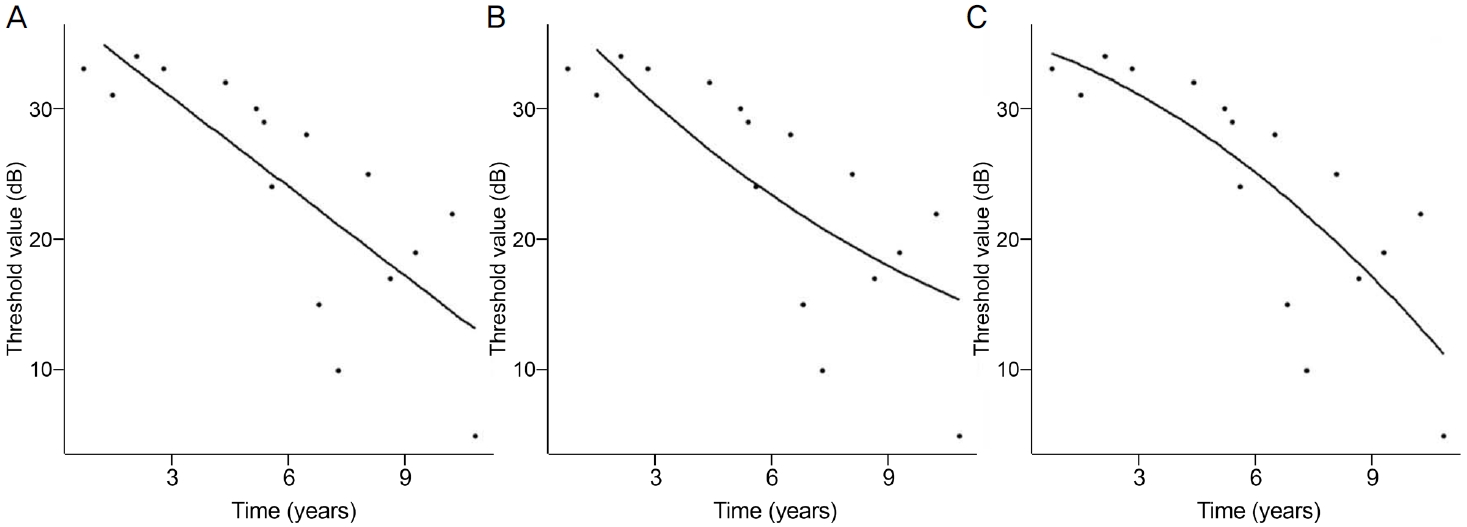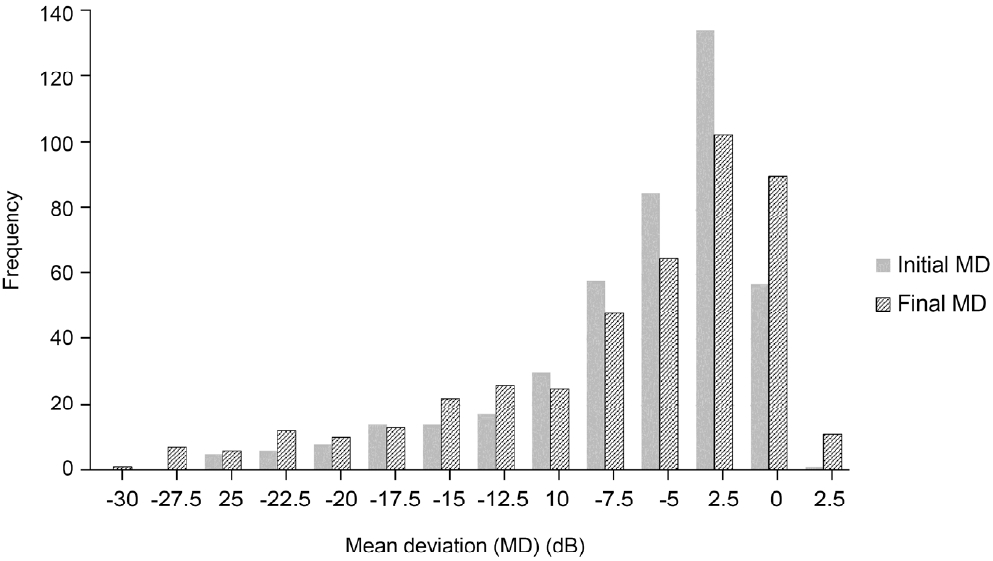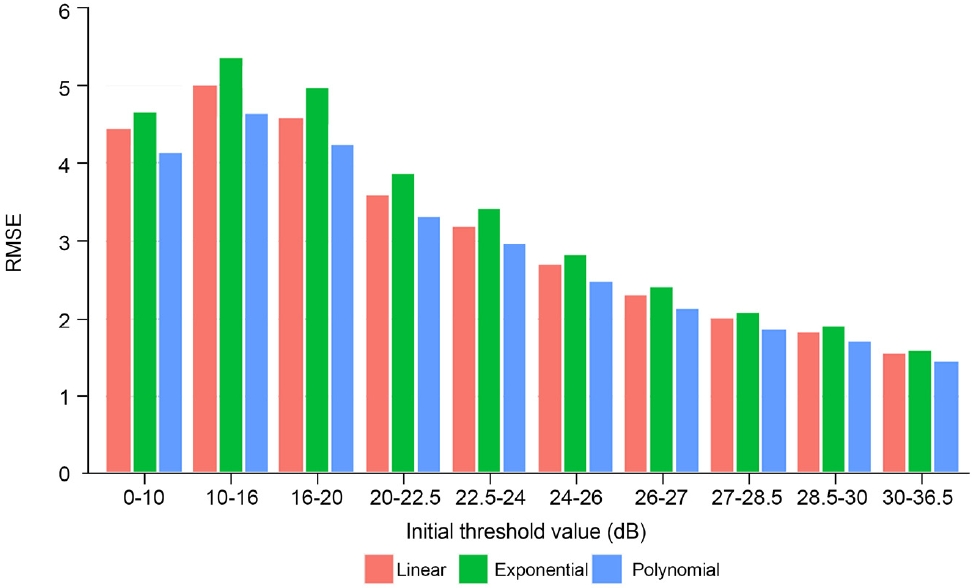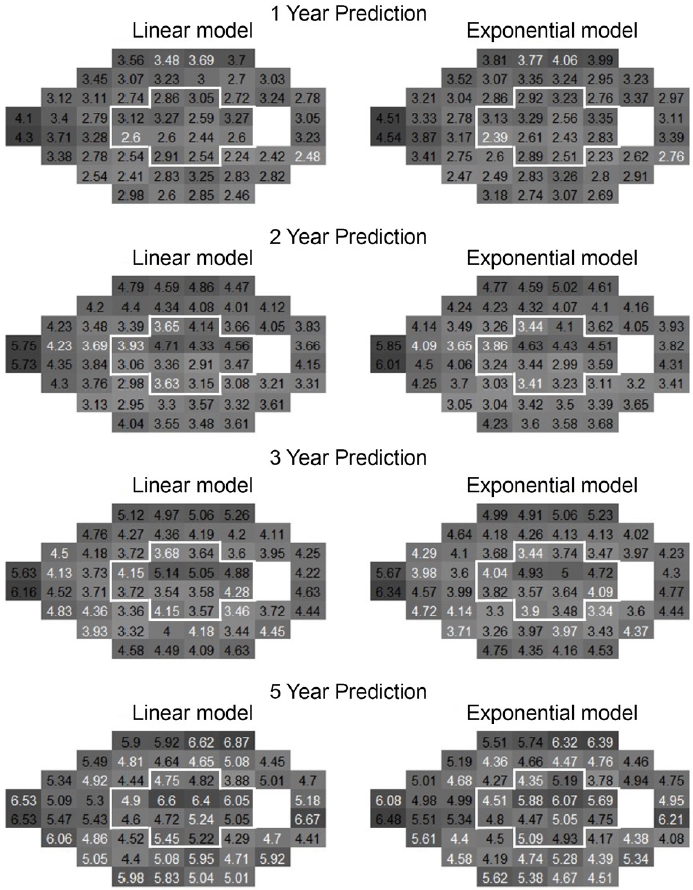 |
 |
| J Korean Ophthalmol Soc > Volume 63(11); 2022 > Article |
|
ĻĄŁļ¼Ėņ┤łļĪØ
ļ¬®ņĀü
ĒĢ£ĻĄŁņØĖ ļģ╣ļé┤ņן ĒÖśņ×ÉņØś ņŗ£ņĢ╝Ļ▓Ćņé¼ Ļ░ü ņ¦ĆņĀÉņØś ļ│ĆĒÖöļź╝ ļČäņäØĒĢśņŚ¼ ĒÜīĻĘĆ ļ¬©ļŹĖņØś ņĀüĒĢ®ļÅäņÖĆ ņśłņĖĪ ņä▒ļŖźņØä ļ╣äĻĄÉĒĢśņśĆļŗż.
ļīĆņāüĻ│╝ ļ░®ļ▓Ģ
6ļģä ņØ┤ņāü ņŗ£Ē¢ēĒĢ£ ņŗ£ņĢ╝Ļ▓Ćņé¼Ļ░Ć 10ĒÜī ņØ┤ņāüņØĖ Ļ░£ļ░®Ļ░üļģ╣ļé┤ņןĻ│╝ ļģ╣ļé┤ņןņØśņ”Ø ĒÖśņ×ÉņŚÉņä£ ņŗ£ņĢ╝Ļ▓Ćņé¼ Ļ░ü ņ¦ĆņĀÉņŚÉņä£ ņŗ£Ļ░äņŚÉ ļö░ļźĖ ņŚŁņ╣śĻ░Æ ļ│ĆĒÖöņŚÉ ņäĀĒśĢ, ņ¦ĆņłśĒśĢ, ļŗżĒĢŁĒśĢ ĒÜīĻĘĆļČäņäØņØä ņŗ£Ē¢ēĒĢśņśĆļŗż. ĒÅēĻĘĀņĀ£Ļ│▒ĻĘ╝ņśżņ░©(root mean squared error, RMSE)ļź╝ ņØ┤ņÜ®ĒĢśņŚ¼, ņäĖ ļ¬©ļŹĖņØś ņĀüĒĢ®ļÅäļź╝ ļ╣äĻĄÉĒĢśņśĆĻ│Ā, ņ▓½ 5ļģäņØś ņŗ£ņĢ╝Ļ▓Ćņé¼ļĪ£ ļ¬©ļŹĖ ņČöņĀĢ Ēøä, 1, 2, 3, 5ļģä ĒøäņØś ņŚŁņ╣śĻ░ÆņØä ņśłņĖĪĒĢśņŚ¼ ņśłņĖĪ ņä▒ļŖźņØä ļ╣äĻĄÉĒĢśņśĆļŗż. ņżæņŗ¼ļČĆņÖĆ ņŻ╝ļ│ĆļČĆ ņśüņŚŁ ļ░Å ņ┤łĻĖ░ ņŚŁņ╣śĻ░ÆņŚÉ ļö░ļØ╝ ņśłņĖĪ ņä▒ļŖźņØä ļ╣äĻĄÉĒĢśņśĆļŗż.
Ļ▓░Ļ│╝
280ļ¬ģ 439ņĢłņØś ĒÅēĻĘĀ Ļ▓ĮĻ│╝ Ļ┤Ćņ░░ ĻĖ░Ļ░äĻ│╝ ņŗ£ņĢ╝Ļ▓Ćņé¼ Ļ░£ņłśļŖö 9.64ļģäĻ│╝ 13.02Ļ░£ņśĆļŗż. ņĀüĒĢ®ļÅä RMSEļŖö ļŗżĒĢŁĒśĢņØ┤ Ļ░Ćņן ļé«ņĢśļŗż(p<0.001). 1ļģä ņśłņĖĪņŚÉņä£ ņäĀĒśĢņØ┤, 3, 5ļģä ņśłņĖĪņŚÉņä£ ņ¦ĆņłśĒśĢņØś RMSEĻ░Ć Ļ░Ćņן ļé«ņĢśļŗż(ļ¬©ļōĀ p<0.001). 1, 2ļģä ņśłņĖĪ ņŗ£, ņ┤łĻĖ░ ņŚŁņ╣śĻ░Æ 0-7 decibel (dB)ņŚÉņä£ ņ¦ĆņłśĒśĢņØ┤, 20-27 dBņŚÉņä£ ņäĀĒśĢņØ┤ RMSEĻ░Ć Ļ░Ćņן ļé«ņĢśļŗż(ļ¬©ļōĀ p<0.001). ņäĀĒśĢĻ│╝ ņ¦ĆņłśĒśĢ ļ¬©ļŹĖņØä ļ╣äĻĄÉĒĢśņśĆņØä ļĢī, ņŗ£ņĢ╝ ņŻ╝ļ│ĆļČĆ 1ļģä ņśłņĖĪņŚÉņä£ ņäĀĒśĢņØ┤, 3, 5ļģä ņśłņĖĪņŚÉņä£ ņ¦ĆņłśĒśĢņØ┤ RMSEĻ░Ć ļŹö ļé«ņĢśļŗż(ļ¬©ļōĀ p<0.001). ņŗ£ņĢ╝ ņżæņŗ¼ļČĆ 2ļģä ņśłņĖĪļČĆĒä░ ņ¦ĆņłśĒśĢņØś RMSEĻ░Ć ņäĀĒśĢļ│┤ļŗż ļŹö ļé«ņĢśļŗż(ļ¬©ļōĀ pŌēż0.015).
ABSTRACT
Purpose
To evaluate the utility of pointwise modeling for predicting visual field (VF) progression in Korean glaucoma patients.
Methods
Open-angle glaucoma or glaucoma suspect patients with VFs Ōēź 10 times, who were followed-up for Ōēź 6 years, wereincluded. Linear, exponential, and polynomial regression of threshold values at each test point against time were performed. Model fit was evaluated based on root mean squared error (RMSE) for the entire longitudinal VF series. To evaluate prediction ability, VFs from the first 5 years were used to estimate model parameters, followed by calculation of threshold values for 1, 2, 3, 5 years to obtain RMSE. Prediction ability was compared regarding initial threshold value and also central and peripheral VF area.
Results
Four hundred thirty-nine eyes (280 patients) were included. The mean follow-up duration and number of VF tests were 9.64 years and 13.02, respectively. When fitting the entire VF series, polynomial model had the lowest RMSE (p < 0.001). For 1-year predictions, linear model had the lowest RMSE, while exponential model had the lowest RMSE for 3- and 5-year predictions (p < 0.001). For 1- and 2-year predictions, exponential and linear models had the lowest RMSEs, with initial sensitivities of 0-7 and 20-27 decibel (dB), respectively (p < 0.001). Compared to exponential model, linear model had lower RMSE for 1-year, but higher RMSE for 3- and 5-year at peripheral VF area (p < 0.001). For central VF area, exponential model had lower RMSEs for 2-, 3-, and 5-year predictions compared to linear model (p Ōēż 0.015).
Conclusions
The linear model outperformed the exponential model for short-term predictions, while the exponential model was better for long-term predictions. The prediction performance of the exponential model was superior to that of the linear model for central VFs, and for test points with lower initial sensitivities.
ļģ╣ļé┤ņןņØ┤ļ×Ć ĒŖ╣ņ¦ĢņĀüņØĖ ņŗ£ņŗĀĻ▓ĮņåÉņāüĻ│╝ ņŗ£ņĢ╝Ļ▓░ņåÉņØ┤ ņ¦äĒ¢ēĒĢśļŖö ņ¦łĒÖśņØ┤ļŗż. ļģ╣ļé┤ņןņä▒ ņŗ£ņĢ╝Ļ▓░ņåÉņØś ņ¦äĒ¢ēņØä ļ░£Ļ▓¼ĒĢśļŖö Ļ▓āņØĆ ļģ╣ļé┤ņן ĒÖśņ×ÉņØś ņ╣śļŻīļź╝ Ļ▓░ņĀĢĒĢśļŖö ļŹ░ ņ׳ņ¢┤ņä£ ļ¦żņÜ░ ņżæņÜöĒĢśļ®░, Ēśäņ×¼ Ēæ£ņżĆ ņ×ÉļÅÖņŗ£ņĢ╝Ļ▓Ćņé¼(standard automated perimetry)ļź╝ ņØ┤ņÜ®ĒĢ£ ņŗ£ņĢ╝ ĒÅēĻ░ĆĻ░Ć ļģ╣ļé┤ņןņä▒ ņŗ£ņĢ╝Ļ▓░ņåÉņØś ņ¦äĒ¢ēņØä ĒÖĢņØĖĒĢśļŖö Ēæ£ņżĆ Ļ▓Ćņé¼ ļ░®ļ▓Ģņ£╝ļĪ£ ņé¼ņÜ®ļÉśĻ│Ā ņ׳ļŗż[1]. ļģ╣ļé┤ņןņä▒ ņŗ£ņĢ╝Ļ▓░ņåÉņØś ņ¦äĒ¢ēņØä ĒīÉļ│äĒĢśļŖö ĻĖ░ņżĆņ£╝ļĪ£ ļŗżņ¢æĒĢ£ ļ░®ļ▓ĢņØ┤ ņĀ£ņŗ£ļÉśņ¢┤ ņÖöļŖöļŹ░, Advanced Glaucoma Intervention Study (AGIS), Collaborative Initial Glaucoma Treatment Study (CIGTS), Early Manifest Glaucoma Trial (EMGT), Ocular Hypertension Treatment Study (OHTS)ņÖĆ Ļ░ÖņØĆ ļīĆĻĘ£ļ¬© ļ¼┤ņ×æņ£ä ņ×äņāüņŗ£ĒŚśļōżņØ┤ ņŗ£ņĢ╝Ļ▓Ćņé¼ņØś ļ│ĆņłśļōżņØä ņØ┤ņÜ®ĒĢśņŚ¼ ņĀ£ņŗ£ĒĢ£ rule-based criteriaņŚÉņä£ļČĆĒä░ Humphrey visual field analyzerņŚÉņä£ ņĀ£Ļ│ĄĒĢśļŖö Glaucoma progression analysisņÖĆ Ļ░ÖņØĆ event-based analysisĻ░Ć ņ¦äĒ¢ē ĒīÉļ│äņŚÉ ņØ┤ņÜ®ļÉśĻ│Ā ņ׳ļŗż[2-6]. ĒĢśņ¦Ćļ¦ī ņØ┤ļ¤¼ĒĢ£ ļ░®ļ▓ĢļōżņØĆ ņŗ£ņĢ╝Ļ▓░ņåÉņØś ļ│ĆĒÖöņ£©(rate of change)ņŚÉ ļīĆĒĢ£ ņĀĢļ│┤ļź╝ ņĀ£Ļ│ĄĒĢśņ¦Ć ļ¬╗ĒĢśļ®░, ļ╣ĀļźĖ ņŗ£ņĢ╝Ļ▓░ņåÉņØä ļ│┤ņØ┤ļŖö ĒÖśņ×ÉņŚÉĻ▓īļŖö ņĪ░ĻĖ░ņŚÉ ņĀüĻĘ╣ņĀü ņ╣śļŻīļź╝ ņŗ£Ē¢ēĒĢśļŖö Ļ▓āņØ┤ ņżæņÜöĒĢśļ»ĆļĪ£ ņŗ£ņĢ╝Ļ▓░ņåÉņØś ļ│ĆĒÖöņ£© ĒÖĢņØĖņØä ņ£äĒĢ£ trend-based analysisĻ░Ć ņŚ░ĻĄ¼ ļ░Å Ļ░£ļ░£ļÉśņŚłļŗż.[7]. Visual field index (VFI) ņÖĆ mean deviation (MD)Ļ│╝ Ļ░ÖņØ┤ global indexļź╝ ņØ┤ņÜ®ĒĢ£ global trend-based analysisĻ░Ć ņ׳ļŖö ļ░śļ®┤, ņŗ£ņĢ╝Ļ▓Ćņé¼ņØś Ļ░ü ņ¦ĆņĀÉņŚÉ ļīĆĒĢśņŚ¼ ņŗ£ņĢ╝Ļ▓░ņåÉņØś ļ│ĆĒÖöņ£©ņØä Ļ│äņé░ĒĢśļŖö pointwise trend-based analysisļÅä ņ׳ļŗż[8-10].
Pointwise trend-based analysisņØś Ļ▓ĮņÜ░, ņŗ£ņĢ╝Ļ▓Ćņé¼ņØś Ļ░ü ņ¦ĆņĀÉņŚÉņä£ ņŗ£Ļ░äņŚÉ ļö░ļźĖ ņŗ£ņĢ╝Ļ▓░ņåÉņØś ļ│ĆĒÖöļź╝ ļŗżņ¢æĒĢ£ ĒÜīĻĘĆ ļ¬©ļŹĖņØä ĒåĄĒĢ┤ ļČäņäØĒĢśņśĆļŖöļŹ░, ļīĆĒæ£ņĀüņ£╝ļĪ£ ņäĀĒśĢ(linear) ļ¬©ļŹĖņØ┤ Ļ░Ćņן ļ¦ÄņØ┤ ņŚ░ĻĄ¼ļÉśņŚłļŗż[11,12]. ņØ┤ ņÖĖņŚÉļÅä ņ¦ĆņłśĒśĢ(exponential), ļĪ£ĻĘĖĒśĢ(logistic), ļŗżĒĢŁĒśĢ(polynomial)Ļ│╝ Ļ░ÖņØĆ ļŗżņ¢æĒĢ£ ĒÜīĻĘĆ ļ░®ļ▓ĢņØä ĒåĄĒĢśņŚ¼ ļ¬©ļŹĖņØś ņĀüĒĢ® ņĀĢļÅäļ┐Éļ¦īņØ┤ ņĢäļŗłļØ╝ ņśłņĖĪ ņä▒ļŖźļÅä ļ╣äĻĄÉļÉśņŚłļŗż[12-16]. ĒŖ╣Ē׳, Chen et al [14]Ļ│╝ Caprioli et al [13]ņØĆ ņŗ£ņĢ╝Ļ▓Ćņé¼ņØś Ļ░ü ņ¦ĆņĀÉņŚÉ ļö░ļØ╝ ņŗ£ņĢ╝Ļ▓░ņåÉņØś ļ│ĆĒÖöņ£©ņØ┤ ļŗżļź╝ Ļ▓āņØ┤ļØ╝ļŖö Ļ░ĆņĀĢ ĒĢśņŚÉ ļŗżņ¢æĒĢ£ ĒÜīĻĘĆ ļ¬©ļŹĖņØä ļ│æĒĢ®ĒĢśņŚ¼ pointwise trendbased analysisļź╝ ņŗ£ļÅäĒĢśņśĆļŗż.
ņĢäņŗ£ņĢä ņØĖņóģņØĆ ļŗżļźĖ ņØĖņóģņŚÉ ļ╣äĒĢ┤ ĻĘ╝ņŗ£ ļō▒ņØś ņ£äĒŚśņØĖņ×É ļČäĒżĻ░Ć ļåÆĻ│Ā ņĀĢņāüņĢłņĢĢļģ╣ļé┤ņן ļō▒ņØś ņ£Āļ│æļźĀņØ┤ ņ£ĀņØśĒĢśĻ▓ī ļåÆļŗż[17,18]. ĒĢśņ¦Ćļ¦ī Ēśäņ×¼Ļ╣īņ¦Ć ņĢäņŗ£ņĢäņØĖņØä ļīĆņāüņ£╝ļĪ£ ļģ╣ļé┤ņןņä▒ ņŗ£ņĢ╝Ļ▓░ņåÉ ļ│ĆĒÖöņŚÉ ļīĆĒĢ┤ ņŗ£ņĢ╝Ļ▓Ćņé¼ņØś Ļ░ü ņ¦ĆņĀÉņŚÉņä£ ņŗ£Ļ░äņŚÉ ļö░ļźĖ ĒÜīĻĘĆļČäņäØņØä ņŗ£Ē¢ēĒĢ£ ņŚ░ĻĄ¼Ļ░Ć ļČĆņĪ▒ĒĢśļŗż. ņØ┤ņŚÉ ļ│Ė ņŚ░ĻĄ¼ņŚÉņä£ļŖö ĒĢ£ĻĄŁņØĖ ļģ╣ļé┤ņן ĒÖśņ×ÉņŚÉ ņ׳ņ¢┤ņä£ Ēæ£ņżĆņ×ÉļÅÖņŗ£ņĢ╝Ļ▓Ćņé¼ļ▓ĢņØś Ļ░ü Ļ▓Ćņé¼ ņ¦ĆņĀÉņŚÉņä£ņØś ņŗ£Ļ░äņŚÉ ļö░ļźĖ ļģ╣ļé┤ņןņä▒ ņŗ£ņĢ╝Ļ▓░ņåÉ ļ│ĆĒÖöļź╝ ņäĀĒśĢ(linear), ņ¦ĆņłśĒśĢ(exponential), ļŗżĒĢŁĒśĢ(polynomial)ņØś ĒÜīĻĘĆļČäņäØņØä ĒåĄĒĢśņŚ¼ ļ¬©ļŹĖņŚÉ ņĀüĒĢ®ņŗ£ĒéżĻ│Ā ņØ┤Ēøä ļ│ĆĒÖöļź╝ ņśłņĖĪĒĢ┤ļ│┤Ļ│Āņ×É ĒĢ£ļŗż.
6ļģä ņØ┤ņāü Ļ▓ĮĻ│╝ Ļ┤Ćņ░░ĒĢśņśĆņ£╝ļ®░ ņŗ£Ē¢ēĒĢ£ ņŗ£ņĢ╝Ļ▓Ćņé¼ņØś ĒܤņłśĻ░Ć 10ĒÜī ņØ┤ņāüņØĖ ļģ╣ļé┤ņן ĒÖśņ×ÉļōżņØä ļīĆņāüņ£╝ļĪ£ ņŚ░ĻĄ¼ļź╝ ņŗ£Ē¢ēĒĢśņśĆļŗż. ņŗĀļó░ļÅä ņ¦ĆĒæ£ņŚÉņä£ ņŻ╝ņŗ£ ņāüņŗżņØ┤ 30% ņØ┤ĒĢś, Ļ░ĆņØīņä▒ ļ░śņØæņØ┤ 30% ņØ┤ĒĢś, Ļ░Ćņ¢æņä▒ ļ░śņØæņØ┤ 15% ņØ┤ĒĢśņØĖ ņŗ£ņĢ╝Ļ▓Ćņé¼ļ¦ī ļČäņäØņŚÉ ĒżĒĢ©ļÉśņŚłļŗż. ņŗ£ņĢ╝Ļ▓Ćņé¼ņØś ĒĢÖņŖĄ ĒÜ©Ļ│╝ļź╝ ļ░░ņĀ£ĒĢśĻĖ░ ņ£äĒĢ┤ ņ┤łĻĖ░ 2ĒÜīņØś ņŗ£ņĢ╝Ļ▓Ćņé¼ļŖö ļČäņäØņŚÉņä£ ņĀ£ņÖĖĒĢśņśĆļŗż[19,20]. ļ¦īņĢĮ ņŗ£ņĢ╝Ļ▓Ćņé¼ņØś ĒĢ£ ņ¦ĆņĀÉņŚÉņä£ņØś ņ┤łĻĖ░ 3ĒÜīņØś ņŚŁņ╣śĻ░ÆņØ┤ ļ¬©ļæÉ 0 decibel (dB)ņØĖ Ļ▓ĮņÜ░ ĻĘĖ ņ¦ĆņĀÉņØĆ ļČäņäØņŚÉņä£ ņĀ£ņÖĖļÉśņŚłļŗż. ļ¬©ļōĀ ņŗ£ņĢ╝Ļ▓Ćņé¼ļŖö Humphrey Field Analyzer (Carl Zeiss Meditec Inc, Dublin, CA, USA)ņØś 24-2 SITA standard ņĖĪņĀĢļ▓Ģņ£╝ļĪ£ ņŗ£Ē¢ēļÉśņŚłĻ│Ā, size III white ņŗ£Ēæ£Ļ░Ć ņé¼ņÜ®ļÉśņŚłļŗż. ļČäņäØņŚÉļŖö ņŗ£ņĢ╝Ļ▓Ćņé¼ņØś Ļ░ü Ļ▓Ćņé¼ ņ¦ĆņĀÉ(test location)ņŚÉņä£ņØś ņŚŁņ╣śĻ░Æ(threshold value, THV)ņØ┤ dB ļŗ©ņ£äļĪ£ ņØ┤ņÜ®ļÉśņŚłļŗż. ļ│Ė ņŚ░ĻĄ¼ļŖö ņāØļ¬ģņ£żļ”¼ņŗ¼ņØśņ£äņøÉĒÜī(Institutional Review Board)ļĪ£ļČĆĒä░ ņŖ╣ņØĖņØä ļ░øņĢśņ£╝ļ®░(ņŖ╣ņØĖ ļ▓łĒśĖ: 2203-025-113) Ļ▓Ćņé¼ņÖĆ ļČäņäØ Ļ│╝ņĀĢņØĆ Declaration of HelsinkiņŚÉ ņØśĻ▒░ĒĢśņŚ¼ ņŗżĒ¢ēļÉśņŚłļŗż.
ņŗ£ņĢ╝Ļ▓Ćņé¼ņØś ļæÉ ĻĄ░ļŹ░ņØś ļ¦╣ņĀÉņØä ņĀ£ņÖĖĒĢ£ Ļ░ü ņ¦ĆņĀÉņŚÉņä£ņØś ņŗ£Ļ░äņŚÉ ļö░ļźĖ ņŚŁņ╣śĻ░Æ(dB)ņØś ļ│ĆĒÖöļź╝ ņäĀĒśĢ(linear), ņ¦ĆņłśĒśĢ(exponential), ļŗżĒĢŁĒśĢ(polynomial)ņØś ņäĖ Ļ░Ćņ¦Ć ļ░®ņŗØņ£╝ļĪ£ ĒÜīĻĘĆļČäņäØņØä ņŗ£Ē¢ēĒĢśņśĆļŗż. Ļ░ü ļ¬©ļŹĖļōżņØś ņłśĒĢÖņĀü ĒÜīĻĘĆņŗØņØĆ ļŗżņØīĻ│╝ Ļ░Öļŗż(Fig. 1).
ņäĀĒśĢ(linear): y = ╬▒ + ╬▓x where x: time (1)
ņ¦ĆņłśĒśĢ(exponential): Iny = ╬▒ + ╬▓x where x: time (2)
ļŗżĒĢŁĒśĢ(polynomial): y = ╬▒ + ╬▓1x + ╬▓2x2 where x: time (3)
ņóģņåŹļ│ĆņłśļŖö ņŚŁņ╣śĻ░Æ(y) (dB), ļÅģļ”Įļ│ĆņłśļŖö ņŗ£Ļ░ä(x) (ļģä), ╬▒, ╬▓, ╬▓1, ╬▓2ļŖö ĒÜīĻĘĆļČäņäØņØä ĒåĄĒĢ┤ ņé░ņČ£ļÉśļŖö Ļ│äņłśņØ┤ļŗż. ĒÜīĻĘĆ ļ¬©ļŹĖņØĆ ņĄ£ņåīņĀ£Ļ│▒ļ▓ĢņØä ņØ┤ņÜ®ĒĢśņŚ¼ ņé░ņČ£ļÉśņŚłļŗż.
ņŗ£ņĢ╝Ļ▓Ćņé¼ņØś Ļ░ü ņ¦ĆņĀÉņŚÉņä£ ņĀä ĻĖ░Ļ░äņØś ņŚŁņ╣śĻ░ÆņØ┤ Ļ░ü ļ¬©ļŹĖņØś ņĀüĒĢ®ļÅä ĒÅēĻ░Ć(goodness of fit)ļź╝ ņ£äĒĢ┤ ņé¼ņÜ®ļÉśņŚłļŗż. ņśżņ░©ļŖö ļ¬©ļŹĖņØś ņČöņĀĢĻ░Æ(Z ^
ĒÅēĻĘĀ ņĀ£Ļ│▒ĻĘ╝ ņśżņ░©(root mean squared error, RMSE):
where z: actual THV, z ^
ļ¬©ļŹĖņØä ĒåĄĒĢ£ ņŚŁņ╣śĻ░Æ ņśłņĖĪņØä ņ£äĒĢ┤ ņ┤łĻĖ░ 5ļģäĻ░äņØś ņŗ£ņĢ╝Ļ▓Ćņé¼Ļ░Ć ļ¬©ļŹĖ Ļ│äņłśļź╝ ņČöņĀĢĒĢśļŖöļŹ░ ņé¼ņÜ®ļÉśņŚłļŗż. ņČöņĀĢļÉ£ ļ¬©ļŹĖņØä ņØ┤ņÜ®ĒĢśņŚ¼ ņØ┤Ēøä 1ļģä, 2ļģä, 3ļģä, 5ļģä ĒøäņØś ņŚŁņ╣śĻ░ÆņØä ņśłņĖĪĒĢśņśĆļŗż. ņČöņĀĢļÉ£ ņŚŁņ╣śĻ░ÆņØ┤ ņØīņłśņØĖ Ļ▓ĮņÜ░ 0 dBļĪ£ ņĪ░ņĀĢĒĢśņśĆņ£╝ļ®░, ņśłņĖĪ ņŚŁņ╣śĻ░ÆņØ┤ ņāüņŖ╣ļÉśļŖö Ļ▓ĮņÜ░ņŚÉļŖö ņØ┤ņĀä 4Ļ░£ņØś Ļ▓Ćņé¼ Ļ░ÆņØś ĒÅēĻĘĀĻ░Æņ£╝ļĪ£ ļīĆņ▓┤ĒĢśņśĆļŗż. 1ļģä, 2ļģä, 3ļģä, 5ļģä ĒøäņØś ņŚŁņ╣śĻ░ÆņØ┤ Ļ▓░ņĖĪņØĖ Ļ▓ĮņÜ░, ņäĀĒśĢļ│┤Ļ░äļ▓Ģ(linear interpolation)ņØä ņØ┤ņÜ®ĒĢśņśĆļŗż[14]. ņśłņĖĪ ņśżņ░©ļŖö ļ¬©ļŹĖņØś ņśłņĖĪĻ░ÆĻ│╝ ņŗżņĀ£ ņŚŁņ╣śĻ░ÆņØś ņ░©ņØ┤ļĪ£ ņĀĢņØśĒĢ£ Ēøä, RMSEļź╝ ņØ┤ņÜ®ĒĢśņŚ¼ ņŗ£ņĢ╝Ļ▓Ćņé¼ņØś Ļ░ü ņ¦ĆņĀÉņŚÉņä£ņØś Ļ░ü ņŗ£ņĀÉ(1ļģä, 2ļģä, 3ļģä, 5ļģä Ēøä)ņŚÉņä£ ņäĖ ļ¬©ļŹĖņØś ņśłņĖĪ ņä▒ļŖźņØä ļ╣äĻĄÉĒĢśņśĆļŗż. ļŹöļČłņ¢┤ ņŗ£ņĢ╝Ļ▓Ćņé¼ Ļ░ü ņ¦ĆņĀÉļōżņØä ņ┤łĻĖ░ ņŚŁņ╣śĻ░ÆņŚÉ ļö░ļØ╝ ļ¼Čņ¢┤ Ļ░ü ņ┤łĻĖ░ ņŚŁņ╣śĻ░Æ ĻĄ¼Ļ░äņŚÉņä£ ņäĖ ļ¬©ļŹĖņØś ņśłņĖĪ ņä▒ļŖźņØä ļ╣äĻĄÉĒĢśņśĆļŗż. ņØ┤Ēøä ņŗ£ņĢ╝Ļ▓Ćņé¼ 52Ļ░£ Ļ▓Ćņé¼ ņ¦ĆņĀÉņØä ņżæņŗ¼ļČĆ 12ņ¦ĆņĀÉ ļ░Å ņŻ╝ļ│ĆļČĆ 40ņ¦ĆņĀÉņ£╝ļĪ£ ļéśļłäņ¢┤ Ļ░ü ļČĆņ£äņŚÉņä£ ņäĖ ļ¬©ļŹĖņØś ņśłņĖĪ ņä▒ļŖźņØä ļ╣äĻĄÉĒĢśņśĆļŗż.
ņäĀĒśĢ, ņ¦ĆņłśĒśĢ, ļŗżĒĢŁĒśĢ ĒÜīĻĘĆņØś RMSEļŖö ņØ╝ņøÉļČäņé░ļČäņäØ(one-way ANOVA)ņØä ņØ┤ņÜ®ĒĢśņŚ¼ ļ╣äĻĄÉĒĢśņśĆļŗż. ņØ┤Ēøä ņé¼Ēøä Ļ▓ĆņĀĢņØä ņ£äĒĢ┤ņä£ ļ│ĖĒÄśļĪ£ļŗł ĻĄÉņĀĢ(Bonferroni correction) ļ░®ļ▓ĢņØä ņØ┤ņÜ®ĒĢ£ ļīĆņØæ Ēæ£ļ│Ė TĻ▓ĆņĀĢņØä ņŗżņŗ£ĒĢśņśĆļŗż. ļśÉĒĢ£, ņŗ£ņĢ╝Ļ▓Ćņé¼ ņ¦ĆņĀÉņŚÉ ļö░ļźĖ ņäĀĒśĢ(Linear)Ļ│╝ ņ¦ĆņłśĒśĢ(Exponential) ĒÜīĻĘĆņØś RMSE ļ╣äĻĄÉņŚÉļŖö ļīĆņØæĒæ£ļ│Ė TĻ▓ĆņĀĢņØä ņé¼ņÜ®ĒĢśņśĆļŗż. ļ¬©ļŹĖ ņĀüĒĢ®, ņśłņĖĪ ļ░Å RMSE ļ╣äĻĄÉņŚÉ ļīĆĒĢ£ ĒåĄĻ│ä ļČäņäØņØĆ R (4.1.1 ļ▓äņĀä) ĒöäļĪ£ĻĘĖļשņØä ņØ┤ņÜ®ĒĢśņśĆļŗż.
ņ┤Ø ĒÖśņ×É 280ļ¬ģņØś 439ņĢłņØ┤ ļ│Ė ņŚ░ĻĄ¼ņŚÉ ĒżĒĢ©ļÉśņŚłļŗż. ņĄ£ņ┤ł ņŗ£ņĢ╝Ļ▓Ćņé¼ ņŗ£ņØś ĒÅēĻĘĀ ļéśņØ┤ļŖö 60.66 ┬▒ 14.60ņäĖ, ĒÅēĻĘĀ Ļ▓ĮĻ│╝ Ļ┤Ćņ░░ ĻĖ░Ļ░äņØĆ 9.64 ┬▒ 2.14ļģäņØ┤ņŚłļŗż. ĒÖśņ×Éļŗ╣ ļČäņäØņŚÉ ņé¼ņÜ®ļÉ£ ĒÅēĻĘĀ ņŗ£ņĢ╝Ļ▓Ćņé¼ Ļ░£ņłśļŖö 13.02 ┬▒ 2.49ņśĆĻ│Ā, ļČäņäØņŚÉ ņé¼ņÜ®ļÉ£ ņŗ£ņĢ╝Ļ▓Ćņé¼ ņ¦ĆņĀÉņØś Ļ░£ņłśļŖö 21,981Ļ░£ņśĆļŗż. ņĄ£ņ┤ł ĻĘĖļ”¼Ļ│Ā ļ¦łņ¦Ćļ¦ē ņŗ£ņĢ╝Ļ▓Ćņé¼ņØś ĒÅēĻĘĀ MDļŖö Ļ░üĻ░ü -5.95 ┬▒ 5.48 dB, -6.56 ┬▒ 6.94 dBņØ┤ņŚłĻ│Ā, ĻĘĖ ļČäĒż ļ│ĆĒÖöļŖö Figure 2ņÖĆ Ļ░Öļŗż. ņĄ£ņ┤ł ņŗ£ņĢ╝Ļ▓Ćņé¼ņØś ĒÅēĻĘĀ pattern standard deviationņØĆ 5.45 ┬▒ 4.33 dB, ĒÅēĻĘĀ VFIļŖö 87.18 ┬▒ 16.87%ņśĆļŗż(Table 1).
ņŗ£Ļ░äņŚÉ ļö░ļźĖ ņŗ£ņĢ╝Ļ▓Ćņé¼ ņĀäņ▓┤ļź╝ ņØ┤ņÜ®ĒĢśņŚ¼ ņäĀĒśĢ, ņ¦ĆņłśĒśĢ, ļŗżĒĢŁĒśĢ ļ¬©ļŹĖņØś ņäĖ Ļ░Ćņ¦Ć ļ░®ņŗØņ£╝ļĪ£ ļ¬©ļŹĖ ņĀüĒĢ®ņØä ņŗ£Ē¢ēĒĢśņśĆļŗż. ņäĖ ļ¬©ļŹĖņØä ļ╣äĻĄÉĒĢśņśĆņØä ļĢī, ļŗżĒĢŁĒśĢ ļ¬©ļŹĖņØ┤ Ļ░Ćņן ļé«ņØĆ RMSEļź╝ ļ│┤ņśĆļŗż(p<0.001, Table 2).
ņ┤łĻĖ░ ņŚŁņ╣śĻ░ÆņŚÉ ļö░ļØ╝ ņĖĄĒÖöĒĢśņśĆņØä ļĢī, ņ┤łĻĖ░ ņŚŁņ╣śĻ░ÆņØ┤ ņ”ØĻ░ĆĒĢĀņłśļĪØ RMSEĻ░Ć Ļ░ÉņåīĒĢśļŖö Ļ▓ĮĒ¢źņØä ļ│┤ņśĆļŗż(Pearson coefficient=-0.491,p<0.001). ņ┤łĻĖ░ ņŚŁņ╣śĻ░ÆņŚÉ ļö░ļØ╝ ņĖĄĒÖöĒĢśņŚ¼ ņäĖ ļ¬©ļŹĖņØś ņĀüĒĢ®ņØä ļ╣äĻĄÉĒĢśņśĆņØä ļĢī, ļŗżĒĢŁĒśĢ ļ¬©ļŹĖņØ┤ ļ¬©ļōĀ ņ┤łĻĖ░ ņŚŁņ╣śĻ░Æ ņĖĄĒÖö ĻĘĖļŻ╣ņŚÉņä£ Ļ░Ćņן ļé«ņØĆ RMSEļź╝ ļ│┤ņśĆļŗż(p<0.001, Fig. 3).
ņ┤łĻĖ░ 5ļģäĻ░äņØś ņŗ£ņĢ╝Ļ▓Ćņé¼ļź╝ ņØ┤ņÜ®ĒĢśņŚ¼ ļ¬©ļŹĖņØä ņČöņĀĢĒĢ£ ļÆż 1ļģä, 2ļģä, 3ļģä, 5ļģä ĒøäņØś ņŚŁņ╣śĻ░ÆņØä ņśłņĖĪĒĢśņśĆņØä ļĢī, ļŗżĒĢŁĒśĢ ļ¬©ļŹĖņØś RMSEĻ░Ć Ļ░Ćņן ļåÆņĢśļŗż(p<0.001).
ņ¦ĆņłśĒśĢĻ│╝ ņäĀĒśĢ ļ¬©ļŹĖņØä ļ╣äĻĄÉĒĢśņśĆņØä ļĢī, 1ļģä ĒøäņØś ņśłņĖĪ RMSEļŖö ņäĀĒśĢ ļ¬©ļŹĖņØ┤ ļŹö ļé«ņĢśĻ│Ā(p<0.001), 2ļģä ĒøäņØś ņśłņĖĪ RMSEļŖö ļæÉ ļ¬©ļŹĖ ņé¼ņØ┤ņŚÉ ņ░©ņØ┤Ļ░Ć ņŚåņŚłļŗż. 3ļģä, 5ļģä ĒøäņØś ņśłņĖĪ RMSEļŖö ņ¦ĆņłśĒśĢ ļ¬©ļŹĖņØ┤ ņäĀĒśĢ ļ¬©ļŹĖļ│┤ļŗż ļŹö ļé«ņĢśļŗż(ļ¬©ļōĀ p<0.001) (Table 3).
Ļ░ü ņśłņĖĪ ļģäļÅäļ¦łļŗż ņ┤łĻĖ░ ņŚŁņ╣śĻ░ÆņŚÉ ļö░ļØ╝ ņĖĄĒÖöĒĢśņŚ¼ ņäĖ ļ¬©ļŹĖņØś RMSEļź╝ ļ╣äĻĄÉĒĢśņśĆļŗż. 1, 2ļģä ņśłņĖĪņØś Ļ▓ĮņÜ░, ņ┤łĻĖ░ ņŚŁņ╣śĻ░Æ 0-7 dB ĻĄ¼Ļ░äņŚÉņä£ļŖö ņ¦ĆņłśĒśĢ ļ¬©ļŹĖņØ┤, 20-27 dB ĻĄ¼Ļ░äņŚÉņä£ļŖö ņäĀĒśĢ ļ¬©ļŹĖņØś RMSEĻ░Ć Ļ░Ćņן ļé«ņĢśļŗż(ļ¬©ļōĀ P<0.05) (Fig. 4A). 3ļģä Ēøä ņśłņĖĪņØś Ļ▓ĮņÜ░, ņ┤łĻĖ░ ņŚŁņ╣śĻ░ÆņØ┤ 0-11 dB, 28-31 dBņØĖ ĻĄ¼Ļ░äņŚÉņä£ ņ¦ĆņłśĒśĢ ļ¬©ļŹĖņØ┤ Ļ░Ćņן ļé«ņØĆ RMSEļź╝ ļ│┤ņśĆļŗż(ļ¬©ļōĀp<0.05). 5ļģä Ēøä ņśłņĖĪņØś Ļ▓ĮņÜ░ 4-7 dBņØä ņĀ£ņÖĖĒĢ£ ļ¬©ļōĀ ĻĄ¼Ļ░äņŚÉņä£ ņ¦ĆņłśĒśĢ ļ¬©ļŹĖņØ┤ Ļ░Ćņן ļé«ņØĆ RMSEļź╝ ļ│┤ņśĆļŗż(ļ¬©ļōĀ p<0.05) (Fig. 4B).
ņŗ£ņĢ╝Ļ▓Ćņé¼ 52Ļ░£ ņ¦ĆņĀÉņØä ņżæņŗ¼ļČĆ 12Ļ░£ ņ¦ĆņĀÉĻ│╝ ņŻ╝ļ│ĆļČĆ 40Ļ░£ ņ¦ĆņĀÉņØś ļæÉ ņśüņŚŁņ£╝ļĪ£ ļéśļłł Ēøä, Ļ░ü ņśüņŚŁņŚÉņä£ ņäĀĒśĢĻ│╝ ņ¦ĆņłśĒśĢ ļ¬©ļŹĖņØś ņśłņĖĪ RMSEļź╝ ļ╣äĻĄÉĒĢśņśĆļŗż(Table 4). 1ļģä ņ░© ņśłņĖĪņŚÉņä£ ņŻ╝ļ│ĆļČĆ ņŗ£ņĢ╝ņŚÉņä£ļŖö ņäĀĒśĢ ļ¬©ļŹĖņØś RMSEĻ░Ć ņ¦ĆņłśĒśĢ ļ¬©ļŹĖļ│┤ļŗż ļŹö ļé«ņĢśĻ│Ā(p<0.001), ņżæņŗ¼ļČĆ ņŗ£ņĢ╝ņŚÉņä£ļŖö ļæÉ ļ¬©ļŹĖ Ļ░äņØś RMSE ņ░©ņØ┤Ļ░Ć ņŚåņŚłļŗż. 2ļģä ņ░© ņśłņĖĪņŚÉņä£ ņŻ╝ļ│ĆļČĆ ņŗ£ņĢ╝ņŚÉņä£ļŖö ļæÉ ļ¬©ļŹĖ Ļ░äņØś ņ░©ņØ┤Ļ░Ć ņŚåņŚłņ£╝ļéś, ņżæņŗ¼ļČĆ ņŗ£ņĢ╝ņŚÉņä£ļŖö ņ¦ĆņłśĒśĢ ļ¬©ļŹĖņØś RMSEĻ░Ć ņäĀĒśĢļ¬©ļŹĖļ│┤ļŗż ļŹö ļé«ņĢśļŗż(p=0.015). 3, 5ļģä ņ░© ņśłņĖĪņŚÉņä£ ņżæņŗ¼ļČĆņÖĆ ņŻ╝ļ│ĆļČĆ ņŗ£ņĢ╝ ļ¬©ļæÉņŚÉņä£ ņ¦ĆņłśĒśĢ ļ¬©ļŹĖņØś RMSEĻ░Ć ņäĀĒśĢ ļ¬©ļŹĖļ│┤ļŗż ļŹö ļé«ņĢśļŗż(ļ¬©ļōĀ p<0.001).
ņŗ£ņĢ╝Ļ▓Ćņé¼ Ļ░ü ņ¦ĆņĀÉļ¦łļŗż ņäĀĒśĢĻ│╝ ņ¦ĆņłśĒśĢ ļ¬©ļŹĖņØś ņśłņĖĪ RMSEļź╝ ļÅäņČ£ĒĢ£ Ēøä, ņżæņŗ¼ļČĆņÖĆ ņŻ╝ļ│ĆļČĆļĪ£ ņśüņŚŁņØä ļéśļłäņ¢┤ ņäĀĒśĢĻ│╝ ņ¦ĆņłśĒśĢ ļ¬©ļŹĖ ņé¼ņØ┤ņŚÉ ĒåĄĻ│äņĀüņ£╝ļĪ£ ņ£ĀņØśĒĢ£ RMSE ņ░©ņØ┤Ļ░Ć ņ׳ļŖö ņ¦ĆņĀÉņØś Ļ░£ņłśļź╝ ļ╣äĻĄÉ ļČäņäØĒĢśņśĆļŗż(Fig. 5). ņśłņĖĪ ĻĖ░Ļ░äņØ┤ ĻĖĖņ¢┤ņ¦łņłśļĪØ ņ¦ĆņłśĒśĢ ļ¬©ļŹĖņØ┤ ņÜ░ņäĖĒĢ£ ņ¦ĆņĀÉņØś ņłśĻ░Ć ņ”ØĻ░ĆĒĢśņśĆļŗż. 1ļģä ņ░© ņśłņĖĪņŚÉņä£ ņżæņŗ¼ļČĆ 12Ļ░£ ņ¦ĆņĀÉ ņżæ 1Ļ░£ ņ¦ĆņĀÉ(8.33%)ņŚÉņä£ ņ¦ĆņłśĒśĢ ļ¬©ļŹĖņØś RMSEĻ░Ć ņäĀĒśĢ ļ¬©ļŹĖļ│┤ļŗż ļŹö ļé«ņĢśĻ│Ā, ņŻ╝ļ│ĆļČĆ 40Ļ░£ ņ¦ĆņĀÉ ņżæ 3Ļ░£ ņ¦ĆņĀÉ(7.5%)ņŚÉņä£ ņäĀĒśĢ ļ¬©ļŹĖņØś RMSEĻ░Ć ņ¦ĆņłśĒśĢ ļ¬©ļŹĖļ│┤ļŗż ļŹö ļé«ņĢśļŗż. 2ļģä ņ░© ņśłņĖĪņŚÉņä£ ņżæņŗ¼ļČĆ 12Ļ░£ ņ¦ĆņĀÉ ņżæ 3Ļ░£ ņ¦ĆņĀÉ(25%)Ļ│╝ ņŻ╝ļ│ĆļČĆ 40Ļ░£ ņ¦ĆņĀÉ ņżæ 2Ļ░£ ņ¦ĆņĀÉ(5%)ņŚÉņä£ ņ¦ĆņłśĒśĢ ļ¬©ļŹĖņØś RMSEĻ░Ć ņäĀĒśĢ ļ¬©ļŹĖļ│┤ļŗż ļŹö ļé«ņĢśļŗż. 3ļģä ņ░© ņśłņĖĪņŚÉņä£ ņżæņŗ¼ļČĆ 12Ļ░£ ņ¦ĆņĀÉ ņżæ 4Ļ░£ ņ¦ĆņĀÉ(33.3%)Ļ│╝ ņŻ╝ļ│ĆļČĆ 40Ļ░£ ņ¦ĆņĀÉ ņżæ 2Ļ░£ ņ¦ĆņĀÉ(20%)ņŚÉņä£ ņ¦ĆņłśĒśĢ ļ¬©ļŹĖņØś RMSEĻ░Ć ņäĀĒśĢ ļ¬©ļŹĖļ│┤ļŗż ļŹö ļé«ņĢśļŗż. 5ļģä ņ░© ņśłņĖĪņŚÉņä£ ņżæņŗ¼ļČĆ 12Ļ░£ ņ¦ĆņĀÉ ņżæ 7Ļ░£ ņ¦ĆņĀÉ(58.3%)Ļ│╝ ņŻ╝ļ│ĆļČĆ 40Ļ░£ ņ¦ĆņĀÉ ņżæ 21Ļ░£ ņ¦ĆņĀÉ(52.5%)ņŚÉņä£ ņ¦ĆņłśĒśĢ ļ¬©ļŹĖņØś RMSEĻ░Ć ņäĀĒśĢ ļ¬©ļŹĖļ│┤ļŗż ļŹö ļé«ņĢśļŗż.
ļ│Ė ņŚ░ĻĄ¼ Ļ▓░Ļ│╝ņŚÉ ļö░ļź┤ļ®┤ ņŗ£Ļ░äņŚÉ ļö░ļźĖ ņŗ£ņĢ╝Ļ▓Ćņé¼ ņŚŁņ╣śĻ░ÆņØä ņäĀĒśĢ, ņ¦ĆņłśĒśĢ, ļŗżĒĢŁĒśĢ ĒÜīĻĘĆ ļ¬©ļŹĖņØä ņØ┤ņÜ®ĒĢśņŚ¼ Ļ░üĻ░ü ņĀüĒĢ® ņŗ£ņŚÉ ļŗżĒĢŁĒśĢ ļ¬©ļŹĖņØ┤ Ļ░Ćņן ņóŗņØĆ ņĀüĒĢ®ņØä ļ│┤ņśĆņ£╝ļ®░, ņ┤łĻĖ░ ņŚŁņ╣śĻ░ÆņØ┤ ļåÆņØäņłśļĪØ ļŹö ņóŗņØĆ ņĀüĒĢ®ņØä ļ│┤ņśĆņ£╝ļéś, ņśłņĖĪ ņŗ£ņŚÉļŖö ļŗżĒĢŁĒśĢ ļ¬©ļŹĖņØ┤ Ļ░Ćņן ļé«ņØĆ ņä▒ļŖźņØä ļ│┤ņśĆļŗż.
ņäĀĒśĢĻ│╝ ņ¦ĆņłśĒśĢ ļ¬©ļŹĖņØś ņśłņĖĪņØä ļ╣äĻĄÉĒĢśņśĆņØä ļĢī, ļŗ©ĻĖ░ ņśłņĖĪņØĆ ņäĀĒśĢ ļ¬©ļŹĖņØ┤ ļŹö ņÜ░ņłśĒĢśņśĆņ£╝ļéś, ņןĻĖ░ ņśłņĖĪ ņä▒ļŖźņØĆ ņ¦ĆņłśĒśĢ ļ¬©ļŹĖņØ┤ ļŹö ņÜ░ņłśĒĢśņśĆļŗż. ņĄ£ņ┤ł ņŗ£ņĢ╝Ļ▓Ćņé¼ņØś ņŚŁņ╣śĻ░Ć ļé«ņØäņłśļĪØ ņ¦ĆņłśĒśĢ ļ¬©ļŹĖņØ┤, ļåÆņØäņłśļĪØ ņäĀĒśĢ ļ¬©ļŹĖņØ┤ ņÜ░ņłśĒĢ£ ņśłņĖĪ ņä▒ļŖźņØä ļ│┤ņśĆļŗż. ņŗ£ņĢ╝ ņŻ╝ļ│ĆļČĆņØś ļŗ©ĻĖ░ ņśłņĖĪņŚÉļŖö ņäĀĒśĢ ļ¬©ļŹĖņØ┤ ļŹö ņÜ░ņøöĒĢśņśĆņ£╝ļéś, ņןĻĖ░ ņśłņĖĪņŚÉņä£ļŖö ņ¦ĆņłśĒśĢ ļ¬©ļŹĖņØ┤ ļŹö ņÜ░ņłśĒĢśņśĆļŗż. ņŗ£ņĢ╝ ņżæņŗ¼ļČĆ ņśłņĖĪņŚÉņä£ļŖö ņ¦ĆņłśĒśĢ ļ¬©ļŹĖņØ┤ ņäĀĒśĢ ļ¬©ļŹĖļ│┤ļŗż ļŹö ļø░ņ¢┤ļé£ ņä▒ļŖźņØä ļ│┤ņśĆļŗż.
ņäĀĒśĢ, ņ¦ĆņłśĒśĢ, ļŗżĒĢŁĒśĢ ļ¬©ļŹĖņØä ņØ┤ņÜ®ĒĢśņŚ¼ ņŗ£ņĢ╝Ļ▓Ćņé¼ ņĀä ĻĄ¼Ļ░äņŚÉ ļīĆĒĢśņŚ¼ ņĀüĒĢ®ņØä ņŗ£Ē¢ē ņŗ£ņŚÉ ļŗżĒĢŁĒśĢ ļ¬©ļŹĖņØ┤ Ļ░Ćņן ņóŗņØĆ ņĀüĒĢ®ļÅäļź╝ ļ│┤ņśĆļŗż. ĻĘĖ ņØ┤ņ£ĀļŖö ļŗżĒĢŁĒśĢ ļ¬©ļŹĖņØ┤ ļ¬©ļŹĖ ĒÜīĻĘĆļČäņäØņØä ĒĢĀ ļĢī ņäĀĒśĢņØ┤ļéś ņ¦ĆņłśĒśĢ ļ¬©ļŹĖņŚÉ ļ╣äĒĢ┤ņä£ 1Ļ░£ ļŹö ļ¦ÄņØĆ Ļ│äņłśļź╝ Ļ░Ćņ¦ĆĻ│Ā ņ׳ĻĖ░ ļĢīļ¼ĖņØ┤ļŗż[21]. ļŗżĒĢŁĒśĢ ļ┐Éļ¦īņØ┤ ņĢäļŗłļØ╝ ļĪ£ĻĘĖĒśĢ ļ¬©ļŹĖņØä ņØ┤ņÜ®ĒĢśņŚ¼ ņĀüĒĢ®ņØä ņŗ£ļÅäĒĢ£ ņŚ░ĻĄ¼ņŚÉņä£ļÅä ļĪ£ĻĘĖĒśĢ ļ¬©ļŹĖņØ┤ ņäĀĒśĢņØ┤ļéś ņ¦ĆņłśĒśĢ ļ¬©ļŹĖņŚÉ ļ╣äĒĢśņŚ¼ ļ¬©ļŹĖ ĒÜīĻĘĆ ņŗ£ņŚÉ 1Ļ░£ ļŹö ļ¦ÄņØĆ Ļ│äņłśļź╝ Ļ░Ćņ¦Ćļ»ĆļĪ£ Ļ░Ćņן ļø░ņ¢┤ļé£ ņĀüĒĢ®ļÅäļź╝ ļ│┤ņśĆļŗż[14]. ĒĢśņ¦Ćļ¦ī ņĀüĒĢ®ļÅäĻ░Ć Ļ░Ćņן ļåÆņØĆ ļ¬©ļŹĖņØ┤ Ļ░Ćņן ņóŗņØĆ ņśłņĖĪņØä ĒĢśļŖö Ļ▓āņØĆ ņĢäļŗłļŗż. ņØ┤ļź╝ ĒåĄĻ│äņĀüņ£╝ļĪ£ Ļ│╝ņĀüĒĢ®ņØś ļ¼ĖņĀ£ļØ╝Ļ│Ā ĒĢśļ®░, ļ│Ė ņŚ░ĻĄ¼ņÖĆ ļŹöļČłņ¢┤ ļŗżļźĖ ņŗ£ņĢ╝Ļ▓Ćņé¼ ļ¬©ļŹĖļ¦ü ņŚ░ĻĄ¼ņŚÉņä£ļÅä Ļ░Ćņן ņóŗņØĆ ņĀüĒĢ®ņØä ļ│┤ņØĖ ļ¬©ļŹĖņØ┤ ņśłņĖĪņŚÉņä£ļŖö ņÜ░ņłśĒĢ£ ņä▒ļŖźņØä ļ│┤ņØ┤ņ¦Ć ņĢŖņĢśļŗż[21,22].
ņśłņĖĪ ņä▒ļŖźņŚÉ Ļ┤ĆĒĢśņŚ¼ ņäĀĒśĢĻ│╝ ņ¦ĆņłśĒśĢ ļ¬©ļŹĖ ņżæ ņ¢┤ļŖÉ ļ¬©ļŹĖņØ┤ ļŹö ņÜ░ņłśĒĢ£ņ¦ĆņŚÉ ļīĆĒĢ┤ņä£ ņŚ¼ļ¤¼ ļģ╝ļ¼ĖļōżņØ┤ ļŗżņ¢æĒĢ£ Ļ▓░Ļ│╝ļź╝ ņĀ£ņŗ£ĒĢśņśĆļŗż. McNaught et al [22]Ļ│╝ Bryan et al [23]ņØĆ ņ¦ĆņłśĒśĢ ļ¬©ļŹĖĻ│╝ ļ╣äĻĄÉĒĢśņŚ¼ ņäĀĒśĢ ļ¬©ļŹĖņØ┤ ņśłņĖĪ ņä▒ļŖźņØ┤ ļŹö ņÜ░ņłśĒ¢łļŗżĻ│Ā ļ│┤Ļ│ĀĒĢśņśĆļŗż. McNaught et al [22]ņØś ņŚ░ĻĄ¼ļŖö ļ│Ė ņŚ░ĻĄ¼ņØś 1-2ļģä ņ░© ņśłņĖĪĻ│╝ ļ╣äņŖĘĒĢ£ ņŗ£ĻĖ░ņŚÉ ņśłņĖĪņØä ņŗ£ļÅäĒĢśņśĆĻ│Ā, ņØ┤ ņŚ░ĻĄ¼ļŖö 1ļģä ņ░© ņśłņĖĪņŚÉņä£ ņäĀĒśĢ ļ¬©ļŹĖņØ┤ ņÜ░ņłśĒĢ£ ņä▒ļŖźņØä ļ│┤ņØĖ ļ│Ė ņŚ░ĻĄ¼ Ļ▓░Ļ│╝ņÖĆ ņ£Āņé¼ĒĢ£ Ļ▓░Ļ│╝ļź╝ ļ│┤ņśĆļŗż. Bryan et al [23]ņØś ņŚ░ĻĄ¼ņŚÉņä£ļŖö ļ│Ė ņŚ░ĻĄ¼ņØś ļīĆļץ 2-3ļģä ņ░© ņśłņĖĪņŚÉ ĒĢ┤ļŗ╣ĒĢśļŖö ņŗ£ĻĖ░ņŚÉ ņśłņĖĪņØä ņŗ£Ē¢ēĒĢśņŚ¼ ņäĀĒśĢ ļ¬©ļŹĖņØś ņśłņĖĪ ņä▒ļŖźņØ┤ ļŹö ņÜ░ņłśĒĢ©ņØä ļ│┤ņśĆĻ│Ā, ņØ┤ļŖö ļ│Ė ņŚ░ĻĄ¼ Ļ▓░Ļ│╝ņÖĆļŖö ņØ╝ņ╣śĒĢśņ¦Ć ņĢŖņĢśļŗż.
ņ¦äĒ¢ēļÉ£ ļģ╣ļé┤ņן ĒÖśņ×ÉļōżņØä ļīĆņāüņ£╝ļĪ£ ņŗ£ņĢ╝Ļ▓░ņåÉ ņ¦äĒ¢ēņØä ņśłņĖĪĒĢ£ AGIS ņŚ░ĻĄ¼ļōżņŚÉņä£ ņäĀĒśĢ ļ¬©ļŹĖņŚÉ ļ╣äĒĢ┤ ņ¦ĆņłśĒśĢ ļ¬©ļŹĖņØ┤ ņśłņĖĪņŚÉ ļŹö ņÜ░ņłśĒĢ£ ņä▒ļŖźņØä ļ│┤ņśĆļŗż[13,14,16]. ņØ┤ņŚÉ ļ│Ė ņŚ░ĻĄ¼ņŚÉņä£ļÅä 1, 2ļģä ĒøäņØś ļŗ©ĻĖ░ ņśłņĖĪņŚÉņä£ ņ┤łĻĖ░ ņŚŁņ╣śĻ░ÆņØ┤ ļé«ņĢśļŹś ņ¦ĆņĀÉ(0-7 dB)ņŚÉņä£ļŖö ņ¦ĆņłśĒśĢ ļ¬©ļŹĖņØ┤, ņ┤łĻĖ░ ņŚŁņ╣śĻ░ÆņØ┤ ļåÆņĢśļŹś ņ¦ĆņĀÉ(20-27 dB)ņŚÉņä£ļŖö ņäĀĒśĢ ļ¬©ļŹĖņØ┤ ļŹö ņśłņĖĪ ņä▒ļŖźņØ┤ ļø░ņ¢┤ļé¼ļŗż. ņ┤łĻĖ░ ņŚŁņ╣śĻ░ÆņØ┤ ļåÆņĢśļŹś ņ¦ĆņĀÉņØ┤ļØ╝ļÅä 5ļģä ĒøäņØś ņןĻĖ░ ņśłņĖĪņŚÉņä£ļŖö ņ¦ĆņłśĒśĢ ļ¬©ļŹĖņØ┤ ņÜ░ņłśĒĢ£ ņä▒ļŖźņØä ļ│┤ņśĆļŗż. Chen et al [14]ņØĆ ĒÖśņ×ÉņØś ļģ╣ļé┤ņןņä▒ ņŗ£ņĢ╝Ļ▓░ņåÉņØś ļŗ©Ļ│äĻ░Ć ņŗ£ņĢ╝Ļ▓Ćņé¼ ņāüņØś ņŗżļ¬ģ(perimetric blindness)ņØä Ē¢źĒĢ┤ Ļ░ĆļŖö Ļ▓ĮņÜ░, ņĀÉĻĘ╝ņĀüņØĖ ņ¢æņāü(asymptotic trend)ņØä ļö░ļź┤ĻĖ░ ļĢīļ¼ĖņŚÉ ņ¦ĆņłśĒśĢ Ēś╣ņØĆ ļĪ£ĻĘĖĒśĢ Ļ░ÖņØĆ ĒÜīĻĘĆ ļ¬©ļŹĖņØ┤ ļŹö ņĀüĒĢ®ĒĢĀ Ļ▓āņØ┤ļØ╝Ļ│Ā ĒĢśņśĆļŗż. ņØ┤ļĀćĻ▓ī ļé«ņØĆ ņ┤łĻĖ░ ņŚŁņ╣śĻ░ÆņØä Ļ░Ćņ¦ä Ļ▓ĮņÜ░ Ēś╣ņØĆ ņןĻĖ░ ņśłņĖĪņØĖ Ļ▓ĮņÜ░ņŚÉņä£ ņŗ£ņĢ╝Ļ▓Ćņé¼ ņĢģĒÖö ņ¢æņāüņØ┤ ņĀÉĻĘ╝ņĀüņØĖ ņ¢æņāüņØä ļØäļŖö ņØ┤ņ£ĀļĪ£ļŖö ņŗ£ņĢ╝Ļ▓Ćņé¼ ņŚŁņ╣śĻ░ÆņØ┤ 0 dBņØ┤ļØ╝ļŖö ĒĢśĒĢ£(floor)ņØä Ļ░Ćņ¦ĆĻ│Ā ņ׳ņ£╝ļ®░ ņŚŁņ╣śĻ░ÆņØ┤ ļé«ņØĆ ĻĄ¼Ļ░äņŚÉņä£ļŖö ņŗĀĒśĖ ļīĆ ņ×ĪņØīļ╣ä(signal-to-noise ratio)Ļ░Ć ļé«ņĢä Ļ▓Ćņé¼ Ļ▓░Ļ│╝ņØś ļ│ĆļÅÖņä▒(fluctuation)ņØ┤ ļåÆĻĖ░ ļĢīļ¼ĖņØĖ Ļ▓āņ£╝ļĪ£ ņäżļ¬ģļÉ£ļŗż[11,14].
ņŗ£ņĢ╝Ļ▓Ćņé¼ ņ¦ĆņĀÉņØä ņżæņŗ¼ļČĆņÖĆ ņŻ╝ļ│ĆļČĆļĪ£ ļéśļłäņ¢┤ ņäĀĒśĢĻ│╝ ņ¦ĆņłśĒśĢ ļ¬©ļŹĖņØś ņśłņĖĪ ņä▒ļŖźņØä ļ╣äĻĄÉĒĢśņśĆņØä ļĢī, ņŻ╝ļ│ĆļČĆņØś Ļ▓ĮņÜ░ ņśłņĖĪ ņ┤łĻĖ░ņŚÉļŖö ņäĀĒśĢ ļ¬©ļŹĖņØ┤ ņÜ░ņłśĒĢśņśĆĻ│Ā ņØ┤Ēøä ļæÉ ļ¬©ļŹĖ ņé¼ņØ┤ņŚÉ ņ░©ņØ┤Ļ░Ć ņŚåņ¢┤ņ¦ä ļÆż ņןĻĖ░ ņśłņĖĪņŚÉņä£ļŖö ņ¦ĆņłśĒśĢ ļ¬©ļŹĖņØ┤ ņÜ░ņłśĒĢśņśĆļŗż. ļ░śļ®┤ņŚÉ ņżæņŗ¼ļČĆļŖö 1ļģä ļŗ©ĻĖ░ ņśłņĖĪņŚÉņä£ļŖö ļæÉ ļ¬©ļŹĖņØś ņä▒ļŖź ņ░©ņØ┤Ļ░Ć ņŚåņŚłĻ│Ā 2ļģäņ░© ņśłņĖĪļČĆĒä░ ņ¦ĆņłśĒśĢ ļ¬©ļŹĖņØ┤ ļŹö ņÜ░ņłśĒĢśņśĆļŗż. 1ļģä ļŗ©ĻĖ░ ņśłņĖĪņŚÉņä£ļÅä ņżæņŗ¼ļČĆ 12Ļ░£ ņ¦ĆņĀÉ ņżæ 1Ļ░£ ņ¦ĆņĀÉ(8.33%)ņŚÉņä£ ņ¦ĆņłśĒśĢ ļ¬©ļŹĖņØś ņśłņĖĪ ņä▒ļŖźņØ┤ ņäĀĒśĢ ļ¬©ļŹĖļ│┤ļŗż ņÜ░ņøöĒĢśņśĆĻ│Ā, ņäĀĒśĢ ļ¬©ļŹĖņØś ņśłņĖĪ ņä▒ļŖźņØ┤ ļŹö ņÜ░ņøöĒĢ£ ņ¦ĆņĀÉņØĆ ņŚåņŚłļŗż.
ņĀĢņāüņĢłņĢĢļģ╣ļé┤ņןņØś Ļ▓ĮņÜ░ ņøÉļ░£Ļ░£ļ░®Ļ░üļģ╣ļé┤ņןņŚÉ ļ╣äĒĢ┤ ņŗ£ņĢ╝ Ļ▓░ņåÉņØś ņ¦äĒ¢ēņØ┤ ņŗ£ņĢ╝ņØś ņżæņŗ¼ļČĆņŚÉņä£ ļŹö ņ×ÉņŻ╝ ļ░£ņāØĒĢśĻ│Ā, ļÅÖņ¢æņØĖņŚÉņä£ ņØ┤ļ¤░ ņĀĢņāüņĢłņĢĢļģ╣ļé┤ņןņØś ļ╣äņ£©ņØ┤ ļåÆņØĆ Ļ▓āņ£╝ļĪ£ ņĢīļĀżņĀĖ ņ׳ļŗż[17,24-26]. ļŹöļČłņ¢┤ ĻĘ╝ņŗ£ļź╝ ļÅÖļ░śĒĢ£ ļģ╣ļé┤ņןņØś Ļ▓ĮņÜ░ ņ£ĀļæÉĒÖ®ļ░śņä¼ņ£Ā(papillomacular bundle) ļČĆņ£ä ņåÉņāüņØ┤ ļæÉļō£ļ¤¼ņĀĖ ņżæņŗ¼ļČĆ ņŗ£ņĢ╝ ņĢģĒÖöĻ░Ć ņĪ░ĻĖ░ņŚÉ ļéśĒāĆļéĀ ņłś ņ׳Ļ│Ā, ĻĘ╝ņŗ£ ļśÉĒĢ£ ļÅÖņ¢æņØĖņŚÉņä£ ļ╣łļÅäĻ░Ć ļåÆļŗż[18,27-29]. ĒĢ£ĻĄŁņØĖņØä ļīĆņāüņ£╝ļĪ£ ĒĢ£ ļ│Ė ņŚ░ĻĄ¼ņŚÉņä£ ņĀĢņāü ņĢłņĢĢļģ╣ļé┤ņן ļ░Å ĻĘ╝ņŗ£ņØś ļ╣äņ£©ņØ┤ ļåÆņØä Ļ▓āņ£╝ļĪ£ ņČöņĀĢļÉśļ®░ ņØ┤ņŚÉ ņżæņŗ¼ļČĆ ņśłņĖĪņŚÉņä£ ņ¦ĆņłśĒśĢ ļ¬©ļŹĖņØ┤ ņäĀĒśĢ ļ¬©ļŹĖļ│┤ļŗż ļŹö ņÜ░ņłśĒ¢łļŹś Ļ▓āņ£╝ļĪ£ ņāØĻ░üļÉ£ļŗż. ļ│Ė ņŚ░ĻĄ¼ Ļ▓░Ļ│╝ļź╝ ļ░öĒāĢņ£╝ļĪ£ ņżæņŗ¼ļČĆ ņåÉņāüņØ┤ ĒśĖļ░£ĒĢśļŖö ņĀĢņāüņĢłņĢĢļģ╣ļé┤ņןĻ│╝ ĻĘ╝ņŗ£ ļģ╣ļé┤ņן ĒÖśņ×É, ĻĘĖļ”¼Ļ│Ā ņŗ¼ĒĢ£ ļģ╣ļé┤ņןņä▒ ņŗ£ņŗĀĻ▓Į ņåÉņāüņØä Ļ░Ćņ¦ĆĻ│Ā ņ׳ļŖö ĒÖśņ×ÉņŚÉņä£ ņäĀĒśĢ ļ¬©ļŹĖļ│┤ļŗż ņ¦ĆņłśĒśĢ ļ¬©ļŹĖņØ┤ ļģ╣ļé┤ņן ĒÖśņ×ÉņØś ņéČņØś ņ¦łĻ│╝ Ļ┤ĆļĀ© ņ׳ļŖö ņżæņŗ¼ļČĆ ņŗ£ņĢ╝ ņśłņĖĪņŚÉ ļŹö ļÅäņøĆņØ┤ ļÉĀ ņłś ņ׳ņØä Ļ▓āņ£╝ļĪ£ ņāØĻ░üļÉ£ļŗż[30].
ļ│Ė ņŚ░ĻĄ¼ ĒĢ£Ļ│äņĀÉņ£╝ļĪ£ļŖö ļ¬©ļŹĖņØä ļŗ©ņØ╝ ĒÜīĻĘĆņŗØņ£╝ļĪ£ ĻĄ¼ņä▒ĒĢśņŚ¼ ņŗ£ņĢ╝ ņĢģĒÖö ņåŹļÅäļź╝ ļé«ņČöļŖö ļģ╣ļé┤ņןņłśņłĀņØ┤ļéś ņŗ£ņĢ╝ ņŚŁņ╣śĻ░Æļź╝ ņ”ØĻ░Ćņŗ£ĒéżļŖö ļ░▒ļé┤ņןņłśņłĀ ļō▒ņØś ņśüĒ¢źņØ┤ ĻĄ¼ļČäļÉśņ¦Ć ņĢŖņĢśļŗżļŖö ņĀÉņØ┤ļŗż. ņØ┤ļź╝ Ļ│ĀļĀżĒĢśĻĖ░ ņ£äĒĢ┤ņä£ļŖö ņČöĒøä ļ│ĄĒĢ® ļ¬©ļŹĖ(multimodal functions)ņØä ņØ┤ņÜ®ĒĢ£ ĒøäņåŹ ņŚ░ĻĄ¼Ļ░Ć ĒĢäņÜöĒĢĀ Ļ▓āņ£╝ļĪ£ ņāØĻ░üļÉ£ļŗż. ļŹöļČłņ¢┤, ļ│Ė ņŚ░ĻĄ¼ņŚÉ ĒżĒĢ©ļÉ£ ļīĆļČĆļČäņØś ĒÖśņ×ÉļōżņØĆ ņ¦ĆņŚŁņØśņøÉņŚÉņä£ ņĢłņĢĢĒĢśĻ░ĢņĀ£ļź╝ ņé¼ņÜ®ĒĢśļŹś ņżæņŚÉ ļ│Ė ņŚ░ĻĄ¼Ļ░Ć ņŗ£Ē¢ēļÉ£ ļ│æņøÉņ£╝ļĪ£ ņĀäņøÉļÉ£ Ļ▓ĮņÜ░ļĪ£ ņøÉļ░£Ļ░£ļ░®Ļ░üļģ╣ļé┤ņןĻ│╝ ņĀĢņāüņĢłņĢĢļģ╣ļé┤ņןņØä ņĀĢĒÖĢĒ׳ ĻĄ¼ļČäĒĢśņŚ¼ ņŚ░ĻĄ¼ĒĢśņ¦Ć ļ¬╗ĒĢśņśĆļŹś ņĀÉņØ┤ ĒĢ£Ļ│äņĀÉņ£╝ļĪ£ ņāØĻ░üļÉ£ļŗż.
ļ│Ė ņŚ░ĻĄ¼ļŖö ĒĢ£ĻĄŁņØĖ ļģ╣ļé┤ņן ĒÖśņ×ÉļōżņØä ļīĆņāüņ£╝ļĪ£ ļģ╣ļé┤ņןņä▒ ņŗ£ņĢ╝Ļ▓░ņåÉ ņ¦äĒ¢ēņØä ņäĀĒśĢ, ņ¦ĆņłśĒśĢ, ļŗżĒĢŁĒśĢņØś ĒÜīĻĘĆļČäņäØņØä ņØ┤ņÜ®ĒĢśņŚ¼ ņĀüĒĢ®ņŗ£ĒéżĻ│Ā ņśłņĖĪņØä ņŗ£ļÅäĒĢ£ ņŚ░ĻĄ¼ņØ┤ļŗż. ļŗ©ĻĖ░ ņśłņĖĪ ņŗ£ņŚÉļŖö ņäĀĒśĢ ļ¬©ļŹĖņØ┤, ņןĻĖ░ ņśłņĖĪ ņŗ£ņŚÉļŖö ņ¦ĆņłśĒśĢ ļ¬©ļŹĖņØś ņśłņĖĪ ņä▒ļŖźņØ┤ ņÜ░ņłśĒĢśņśĆļŗż. ĻĘĖļ¤¼ļéś ņżæņŗ¼ļČĆ ņŗ£ņĢ╝ņØś Ļ▓ĮņÜ░ ņŻ╝ļ│ĆļČĆļ│┤ļŗż ņØ┤ļźĖ ņŗ£ĻĖ░ļČĆĒä░ ņ¦ĆņłśĒśĢ ļ¬©ļŹĖņØś ņśłņĖĪ ņä▒ļŖźņØ┤ ņäĀĒśĢ ļ¬©ļŹĖļ│┤ļŗż ļŹö ņÜ░ņøöĒĢśņśĆĻ│Ā, ņ┤łĻĖ░ ņŗ£ņĢ╝Ļ▓Ćņé¼ņØś ņŚŁņ╣śĻ░ÆņØ┤ ļé«ņØĆ Ļ▓ĮņÜ░ņŚÉļÅä ļåÆņØĆ Ļ▓ĮņÜ░ļ│┤ļŗż ņØ┤ļźĖ ņŗ£ĻĖ░ņŚÉ ņ¦ĆņłśĒśĢ ļ¬©ļŹĖņØś ņśłņĖĪ ņä▒ļŖźņØ┤ ņäĀĒśĢ ļ¬©ļŹĖļ│┤ļŗż ļŹö ņÜ░ņøöĒĢśņśĆļŗż. ļ│Ė ņŚ░ĻĄ¼ Ļ▓░Ļ│╝ļŖö Ē¢źĒøä ņČöĻ░Ć ņŚ░ĻĄ¼ļź╝ ĒåĄĒĢśņŚ¼ ĒĢ£ĻĄŁņØĖ ļģ╣ļé┤ņן ĒÖśņ×ÉņØś ņŗ£ņĢ╝Ļ▓░ņåÉ ņ¦äĒ¢ēņŚÉ ļīĆĒĢ£ ņĀĢļ│┤ļź╝ ņĀ£Ļ│ĄĒĢśļŖö ļŹ░ ņ£ĀņÜ®ĒĢśĻ▓ī ņé¼ņÜ®ļÉĀ ņłś ņ׳ņØä Ļ▓āņ£╝ļĪ£ ņāØĻ░üļÉ£ļŗż.
Acknowledgments
This research was supported by a grant from Medical big data and AI-based early detection of visual dysfunction funded by Busan and managed by Busan Techno Park.
Figure┬Ā1.
Examples of regression models fit to the same series of threshold values at a single visual field test location. (A) Linear. (B) Exponential. (C) Polynomial.

Figure┬Ā2.
Frequency distribution of initial and final visual field mean deviation for all eyes included in the study.

Figure┬Ā3.
Comparison of root mean squared error (RMSE) for fitting the model among linear, exponential, and polynomial regression model in each stratified initial threshold value group. The RMSE of the polynomial model was the lowest among the three models throughout all initial threshold value groups.

Figure┬Ā4.
Comparison of root mean squared error (RMSE) among linear, exponential, and polynomial regression model in each stratified initial threshold value group for 1-year (A) and 5-year prediction (B). Asterisk (*) indicates the model with lowest RMSE among the three models with statistically significant difference.

Figure┬Ā5.
Pointwise prediction root mean squared error (RMSE) of linear and exponential model indicated at each visual field test location according to the years predicted. Lighter background color at each visual field location indicates lower RMSE. White lettering of RMSE value indicates statistically significant difference between the linear and exponential model by paired t-test while black lettering indicates no significant difference between the linear and exponential model. White cross-shaped boundary identifies 12 central points in the visual field. As the predicted year increases, the number of white letterings increases in 12 central visual field test points as well as 40 peripheral visual field test points. This indicates that the prediction ability of the exponential model becomes superior to that of linear model in more visual field test points as predicted year increases.

Table┬Ā1.
Demographics and main clinical data of study population
Table┬Ā2.
Comparison of root mean squared error (RMSE) among linear, exponential, and polynomial regression model for fitting threshold value of visual field series
| Model | Average RMSE | P1* | P2ŌĆĀ | P3ŌĆĪ | P4┬¦ |
|---|---|---|---|---|---|
| Linear | 2.44 | <0.001 | <0.001 | <0.001 | <0.001 |
| Exponential | 2.56 | ||||
| Polynomial | 2.26 |
Table┬Ā3.
Comparison of prediction root mean squared error among linear, exponential, and polynomial regression model according to the year predicted
| Years predicted | Number of visual field test points used |
Prediction RMSE |
P1* | P2ŌĆĀ | P3ŌĆĪ | P4┬¦ | ||
|---|---|---|---|---|---|---|---|---|
| Linear | Exponential | Polynomial | ||||||
| 1 | 21,981 | 3.00 | 3.09 | 3.79 | <0.001 | 0.009 | <0.001 | <0.001 |
| 2 | 20,020 | 3.88 | 3.91 | 6.44 | <0.001 | 1.000 | <0.001 | <0.001 |
| 3 | 16,871 | 4.27 | 4.21 | 8.45 | <0.001 | <0.001 | <0.001 | <0.001 |
| 5 | 8,460 | 5.28 | 5.01 | 12.24 | <0.001 | <0.001 | <0.001 | <0.001 |
Table┬Ā4.
Comparison of root mean squared error (RMSE) of central and peripheral visual field test points between linear and exponential model according to the year predicted
|
Prediction RMSE |
p-value* | ||
|---|---|---|---|
| Linear | Exponential | ||
| 1 year prediction | |||
| ŌĆāCentral 12 points | 1.80 | 1.79 | 0.339 |
| ŌĆāPeripheral 40 points | 2.06 | 2.09 | <0.001 |
| 2 years prediction | |||
| ŌĆāCentral 12 points | 2.38 | 2.35 | 0.015 |
| ŌĆāPeripheral 40 points | 2.66 | 2.66 | 0.681 |
| 3 years prediction | |||
| ŌĆāCentral 12 points | 2.60 | 2.55 | <0.001 |
| ŌĆāPeripheral 40 points | 2.92 | 2.88 | <0.001 |
| 5 years prediction | |||
| ŌĆāCentral 12 points | 3.23 | 3.12 | <0.001 |
| ŌĆāPeripheral 40 points | 3.46 | 3.32 | <0.001 |
REFERENCES
1) Brusini P, Johnson CA. Staging functional damage in glaucoma: review of different classification methods. Surv Ophthalmol 2007;52:156-79.


2) Ederer F, Gaasterland DE, Sullivan EK; AGIS Investigators. The Advanced Glaucoma Intervention Study (AGIS): 1. Study design and methods and baseline characteristics of study patients. Control Clin Trials 1994;15:299-325.


3) Musch DC, Lichter PR, Guire KE, Standardi CL. The collaborative initial glaucoma treatment study: study design, methods, and baseline characteristics of enrolled patients. Ophthalmology 1999;106:653-62.


4) Leske MC, Heijl A, Hyman L, Bengtsson B. Early manifest glaucoma trial: design and baseline data. Ophthalmology 1999;106:2144-53.


5) Gordon MO, Kass MA. The ocular hypertension treatment study: design and baseline description of the participants. Arch Ophthalmol 1999;117:573-83.


6) Arnalich-Montiel F, Casas-Llera P, Mu├▒oz-Negrete FJ, Rebolleda G. Performance of glaucoma progression analysis software in a glaucoma population. Graefes Arch Clin Exp Ophthalmol 2009;247:391-7.



8) Bengtsson B, Patella VM, Heijl A. Prediction of glaucomatous visual field loss by extrapolation of linear trends. Arch Ophthalmol 2009;127:1610-5.


9) Bengtsson B, Heijl A. A visual field index for calculation of glaucoma rate of progression. Am J Ophthalmol 2008;145:343-53.


10) Park CS, Yoon HS, Rho SH. Characteristecs of visual field progression in normal tension glaucoma. J Korean Ophthalmol Soc 1998;39:1831-42.
11) Gardiner SK, Swanson WH, Goren D, et al. Assessment of the reliability of standard automated perimetry in regions of glaucomatous damage. Ophthalmology 2014;121:1359-69.



12) Smith SD, Katz J, Quigley HA. Analysis of progressive change in automated visual fields in glaucoma. Invest Ophthalmol Vis Sci 1996;37:1419-28.


13) Caprioli J, Mock D, Bitrian E, et al. A method to measure and predict rates of regional visual field decay in glaucoma. Invest Ophthalmol Vis Sci 2011;52:4765-73.


14) Chen A, Nouri-Mahdavi K, Otarola FJ, et al. Models of glaucomatous visual field loss. Invest Ophthalmol Vis Sci 2014;55:7881-7.


15) Nouri-Mahdavi K, Hoffman D, Ralli M, Caprioli J. Comparison of methods to predict visual field progression in glaucoma. Arch Ophthalmol 2007;125:1176-81.


16) Azarbod P, Mock D, Bitrian E, et al. Validation of point-wise exponential regression to measure the decay rates of glaucomatous visual fields. Invest Ophthalmol Vis Sci 2012;53:5403-9.


17) Stein JD, Kim DS, Niziol LM, et al. Differences in rates of glaucoma among Asian Americans and other racial groups, and among various Asian ethnic groups. Ophthalmology 2011;118:1031-7.



18) Wong YL, Saw SM. Epidemiology of pathologic myopia in Asia and worldwide. Asia Pac J Ophthalmol (Phila) 2016;5:394-402.


19) De Tarso Pierre-Filho P, Gomes PR, Pierre ET, Pierre LM. Learning effect of Humphrey matrix frequency doubling technology perimetry in patients with open-angle glaucoma. Eur J Ophthalmol 2010;20:538-41.



20) Heijl A, Bengtsson B. The effect of perimetric experience in patients with glaucoma. Arch Ophthalmol 1996;114:19-22.


21) Chatfield C. Linear Systems. In: Chatfield C, ed. The Analysis of Time Series: Theory and Practice, 1st ed. Boston: Springer, 1975;277.
22) McNaught AI, Crabb DP, Fitzke FW, Hitchings RA. Modelling series of visual fields to detect progression in normal-tension glaucoma. Graefes Arch Clin Exp Ophthalmol 1995;233:750-5.



23) Bryan SR, Vermeer KA, Eilers PH, et al. Robust and censored modeling and prediction of progression in glaucomatous visual fields. Invest Ophthalmol Vis Sci 2013;54:6694-700.


24) Ahrlich KG, De Moraes CG, Teng CC, et al. Visual field progression differences between normal-tension and exfoliative hightension glaucoma. Invest Ophthalmol Vis Sci 2010;51:1458-63.


25) Park HY, Park SH, Park CK. Central visual field progression in normal-tension glaucoma patients with autonomic dysfunction. Invest Ophthalmol Vis Sci 2014;55:2557-63.


26) Chauhan BC, Drance SM, Douglas GR, Johnson CA. Visual field damage in normal-tension and high-tension glaucoma. Am J Ophthalmol 1989;108:636-42.


27) Tan NYQ, Sng CCA, Jonas JB, et al. Glaucoma in myopia: diagnostic dilemmas. Br J Ophthalmol 2019;103:1347-55.


28) Chihara E, Tanihara H. Parameters associated with papillomacular bundle defects in glaucoma. Graefes Arch Clin Exp Ophthalmol 1992;230:511-7.



-
METRICS

-
- 0 Crossref
- 0 Scopus
- 1,193 View
- 60 Download
- Related articles
-
Choroidal Thickness in Advanced Glaucoma Patients2021 December;62(12)
Characteristics of Visual Field Defects in Korean Advanced Glaucoma2021 August;62(8)
Measuring Blood Viscosity in Normal Tension Glaucoma Patients.2015 May;56(5)




 PDF Links
PDF Links PubReader
PubReader ePub Link
ePub Link Full text via DOI
Full text via DOI Download Citation
Download Citation Print
Print



